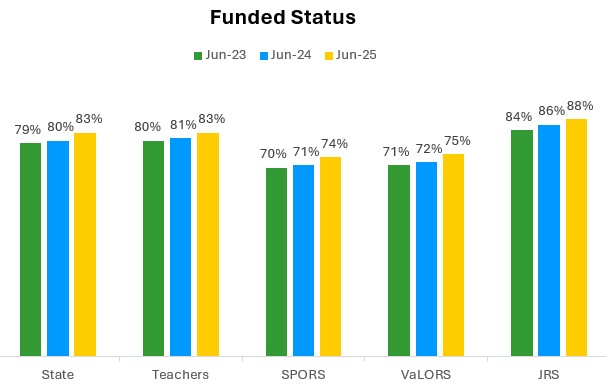Board Certifies FY 2027-2028 Rates for Statewide Plans and OPEBs

At its October meeting, the VRS Board of Trustees voted to certify FY 2027-2028 defined benefit contribution rates for the five statewide retirement plans.
Investment returns have the greatest impact on employer contribution rates. About two-thirds of benefits are funded by investment income. The annualized return on the VRS trust fund portfolio was 9.9% as of June 30, surpassing the actuarially assumed rate of return of 6.75%. VRS has a long-term investment horizon, and the portfolio also exceeded the assumed rate of return for the five-, 10- and 20-year periods ending June 30, 2025.
In addition, VRS and its plan actuary annually review trends in the member population, including hiring, retirements, salaries and other demographic changes. These actuarial trends also play a role in determining employer contribution rates for the next two years.
| Retirement Plan | FY 2027-2028 Board-Certified Defined Benefit Rate |
|---|---|
| State Employees | 11.07% |
| Teachers | 12.20% |
| State Police Officers’ Retirement System (SPORS) | 31.67% |
| Virginia Law Officers’ Retirement System (VaLORS) | 22.60% |
| Judicial Retirement System | 30.49% |
Employers with Hybrid Retirement Plan members will also need to make matching defined contribution hybrid plan contributions of 1.0%-3.5% based on member elections.
The board also certified rates for other post-employment benefits (OPEBs) — group life insurance, the health insurance credit (for eligible state employees and teachers) and the Virginia Sickness and Disability Program (VSDP).
| OPEB Plan | FY 2027-2028 Board-Certified Rate |
|---|---|
| Group Life Insurance | 1.06% |
| Health Insurance Credit (State Employees) | 0.70% |
| Health Insurance Credit (Teachers) | 0.88% |
| Virginia Sickness and Disability Program (VSDP) | 0.42% |
Contribution rates are set by the General Assembly through the state budget process and will take effect July 1, 2026.
State law (§ 51.1-145) requires VRS to set employer contribution rates “in a manner so as to remain relatively level from year to year.” At the same time, VRS must ensure future contributions and current plan assets still are on track to provide for all benefits promised to members and beneficiaries.
A Closer Look at the Statewide Plans
Overall, the funded status of the five statewide retirement plans continues to improve, based on the June 30, 2025, actuarial valuation performed by Gabriel, Roeder, Smith & Company (GRS), the VRS plan actuary.
Collectively the five plans’ funded status increased an average of 2.4% from FY 2024 to FY 2025, continuing on their upward trend the past three years.

Other Highlights from the Most Recent Valuation
- VRS’ FY 2025 investment gains will be spread out over several years to help stabilize the annual contribution rates that employers pay.
- The five statewide plans cover 252,057 employees. Each plan saw its headcount increase from the previous year.
- Average salaries trended higher for members in each plan, exceeding actuarial assumptions.
Political Subdivisions, LODA and VLDP
Later this month, the VRS board will certify contribution rates for:
- Political subdivisions.
- Health insurance credit for political subdivisions.
- Virginia Local Disability Program (VLDP).
- Line of Duty Act (LODA).
Next quarter, VRS will upload to myVRS Navigator the actuarial reports — including the retirement plan contribution rate — for all political subdivisions, along with rates for the health insurance credit, if applicable.
Employer contribution rates provided for non-professional school board and political subdivision plans (VLDP and the health insurance credit for political subdivisions included) are final once certified by the VRS board at its November meeting.
Next Steps
In December, the governor will present the FY 2027-2028 budget, including a recommendation regarding the funding of the VRS-certified contribution rates for statewide plans and other post-employment benefits.
Final VRS contribution rates will be available at the conclusion of the General Assembly session and passage of the state budget next spring.




